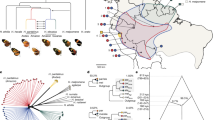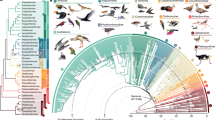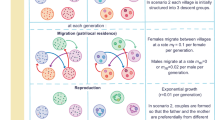Abstract
Species survival is critically dependent on reproductive performance, a complex physiological process under rigorous genetic control. Classical studies of inbreeding in laboratory animals and livestock have shown that increased homozygosity can adversely affect spermatogenesis, ovulation and perinatal mortality and morbidity1–3. For wild populations, the consequences of inbreeding depression have not been examined intensively, although our recent studies of the African cheetah revealed a striking degree of genetic uniformity4,5 combined with an extremely high incidence of structurally abnormal spermatozoa (>70%) in captive6 as well as free-ranging7 males. In this study, we report definitive evidence that the reproductive function of free-ranging mammals can be impaired as a result of demographic contraction followed by inbreeding. In an examination of three distinct lion populations (two from the Serengeti ecosystem in East Africa and a third descended from lions in the Gir Forest of western India), a direct correlation was observed between genetic variability and two physiological traits, incidence of abnormal sperm and circulating testosterone, a critical hormone for spermatogenesis.
Similar content being viewed by others
Article PDF
References
Rice, V. A., Andrews, F. N., Warwick, E. J. & Legates, J. E. Breeding and Improvement of Farm Animals, 188–190 (McGraw-Hill, New York, 1967).
Johannsson, I. & Rendel, J. Genetics and Animal Breeding, 257–377 (Oliver and Boyd, Edinburgh, 1968).
Wyrobek, A. J. Genetics 92, 105–119 (1979).
O'Brien, S. J., Wildt, D. E., Goldman, D., Merril, C. R. & Bush, M. Science 221, 459–462 (1983).
O'Brien, S. J., Wildt, D. E. & Bush, M. Scient. Am. 254, 84–92 (1986).
Wildt, D. E. et al. Biol. Reprod. 29, 1019–1025 (1983).
Wildt, D. E. et al. Biol. Reprod. 36, 351–360 (1987).
Myers, N. Int. Wildlife 5, 4–11 (1975).
Schaller, G. B. The Serengeti Lion: a Study of Predator-Prey Relations (University of Chicago Press, 1972).
Bertram, B. J. Zool. 177, 463–482 (1975).
Hanby, J. D. & Bygott, J. B. in Serengeti: Dynamics of an Ecosystem (eds Sinclair, A. R. E. & Norton-Griffiths, M.) 249–262 (University of Chicago Press, 1979).
Packer, C. in Ecological Aspects of Social Evolution (eds Rubenstein, D. & Wrangham, F.) 429–451 (Princeton Press, Princeton, 1986).
Pusey, A. & Packer, C. Behaviour (in the press).
Joslin, P. in The World's Cats Vol. 1: Ecology and Conservation (ed. Eaton, R. L.) 127–141 (World Wildlife Safari, Winston, Oregon, 1971).
Joslin, P. J. Bombay nat. Hist. Soc. 81, 648–664 (1984).
Fosbrooke, H. E. Afr. Wildlife J. 1, 124–126 (1963).
Caldwell, K. J. Soc. Preserv. Faun. Emp. 34, 62–65 (1938).
O'Brien, S. J. et al. Natn. Geogr. Res. 3, 114–124 (1987).
Ott, R. S. in Current Therapy in Theriogenology (ed. Morrow, D. A.) 125–126 (Saunders, Philadelphia, 1986).
Wildt, D. E. in Wild Mammals in Captivity (ed. Lumpkin, S.) (Sinauer, Sunderland, Massachusetts, in the press).
Lincoln, G. A. in The Testis (eds Burger, H. & de Kretser, D.) 255–302 (Raven, New York, 1981).
Amann, R. P. in Current Therapy in Theriogenology (ed. Morrow, D. A.) 532–538 (Saunders, Philadelphia, 1986).
Bardin, C. W. & Paulsen, C. A. in Textbook of Endocrinology (ed. Williams, R. H.) 293–354 (Saunders, Philadelphia, 1981).
Sharpe, R. M. Biol. Reprod. 30, 29–49 (1984).
Wildt, D. E., Howard, J. G., Hall, L. L. & Bush, M. Biol. Reprod. 34, 937–947 (1986).
O'Brien, S. J. et al. Science 227, 1428–1434 (1985).
Wildt, D. E., Chakraborty, P. K., Meltzer, D. & Bush, M. Biol. Reprod. 30, 665–672 (1984).
Wildt, D. E., Howard, J. G., Chakraborty, P. K. & Bush, M. Biol. Reprod. 34, 949–959 (1986).
Author information
Authors and Affiliations
Rights and permissions
About this article
Cite this article
Wildt, D., Bush, M., Goodrowe, K. et al. Reproductive and genetic consequences of founding isolated lion populations. Nature 329, 328–331 (1987). https://doi.org/10.1038/329328a0
Received:
Accepted:
Issue Date:
DOI: https://doi.org/10.1038/329328a0
Comments
By submitting a comment you agree to abide by our Terms and Community Guidelines. If you find something abusive or that does not comply with our terms or guidelines please flag it as inappropriate.



